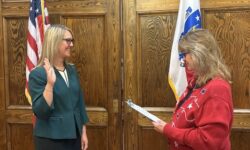[ccfic caption-text format="plaintext"]
By Amelia Tarallo
Hometown Weekly Special Correspondent
To many, cemeteries can be haunting places, where constant reminders of mortality loom.
To others, cemeteries are places of history, like outdoor museums of sorts, free to those who choose to take a walk around them.
Different styles of engravings gives clues about how our ancestors approached death. Memorials tell us how a community was affected by certain events or places.
The communities of Hometown Weekly each have their own unique burial grounds, each giving perspective to the community around them. The following is a guide to some of them.
Wellesley Congregational Cemetery
2 Central Street Wellesley
The Wellesley Congregational Cemetery is a small burial ground located in Wellesley Center. The town used it as a primary final resting place from 1777 to 1893. The cemetery and the still-active Congregational Church are listed in the National Register of Historic Places. There are 263 different grave markers, including headstones, footstones, and memorials. Featured in the cemetery are slate headstones, most common during the 1700s. The headstone of Ensign Ephraim Bullard is one of a few created by the Daniel Hastings workshop within the cemetery. The cemetery includes 11 Revolutionary War veterans, 10 of which have their original headstone, and two Civil War veterans. Though it remains an active cemetery, there has been much work done to ensure that it still resembles its 18th century appearance, including the continued usage of slate in gravestones.
Needham Cemetery
121 Parish Road, Needham Heights
The Needham Cemetery, established in 1710, still serves as the main burial spot for the town. It is the final resting spot for William Carter, who immigrated to Needham from England in 1854 and opened up a business that produced knitted goods. Carter's business grew so much that by the 1870s, he opened up his first mill in Needham. His resting place is marked by a bust of his likeness. His children and wife are buried beside him. Towering above the sprawling green of the cemetery is a large black obelisk made of cannons and cannonballs, which pays tribute to the Civil War veterans of Needham.
Highland Cemetery
Center Street, Dover
Many of the grave markers are unique in their design. One includes the grave of World War Two veteran Frank L. Ouellet. Marked by a traditional headstone, it is accompanied by a rock that has been hollowed out into the shape of a heart. Other graves includes that of Arria Priscilla, whose gravestone claims that she is a "descendant of the poors who gave land for the Salisbury Cathedral in England." The Salisbury Cathedral, built in 1258, remains one of the most studied architectural structures in the world. Visitors taking a walk around this cemetery are sure to find even more interesting markers.
Old South Cemetery
251 South Main Street, Sherborn
Getting to Old South Cemetery can be a bit difficult. But if visitors are willing to climb the steep steps to the burial ground, they will find an abundance of Sherborn's history. The first known person buried in this cemetery was Hopestill Leland, who died in 1655. As the oldest of ten cemeteries located in Sherborn, Old South contains its own unique history. During the 1750s, Old South Cemetery was used as a place to bury victims of the "Holliston Plague.” According to town historians, some people were buried with unmarked graves as a way to prevent nearby Native Americans from knowing how many people had died during the epidemic. The exact illness that killed an eighth of the the population in Holliston is still unknown.
Old Burial Ground
Corner of Main Street and Kendall, Walpole
Surrounded by a traditional colonial rock wall, Old Burial Place in Walpole is the town's earliest established cemetery. The earliest burial was 1718 (Mary Clap) and the latest was 1863 (Chloe Day). 187 people are buried here, including the person who gave the cemetery to the town, Ebenezer Clapp. Joshua Clapp, a relative of Ebenezer, served as a representative of the town at the start of the Revolutionary War. He met with almost 100 other representatives to discuss measures to help the people of Massachusetts during the tense time. Since this cemetery is the oldest in the town, it contains the graves of some of the earliest settlers. Families buried here including the Robbins, Kingsbury, and Blake.
Westwood Cemetery
Nahatan Street at High Street
The Westwood Cemetery was established in 1752. Though it is still active, it is now split into two sections, "Old Westwood Cemetery" and "New Cemetery." Major Robert Steele is one of the many early residents buried in the old section. Major Steele served a drummer boy for the Continental Army during the Battle of Bunker Hill. He died in 1833.
Among the many impressive markers is one dedicated to the David family, which resembles a gothic cloister. An interesting feature of this particular burial ground is a deck that overlooks a portion of the cemetery at the bottom of a hill. As it is one of the more walkable cemeteries on this list, it is advised that visitors take their time for a leisurely stroll around and see what they can find.
Vine Lake Cemetery
625 Main Street, Medfield
Vine Lake Cemetery is make up of acres. Established in 1651, it continues to be the town’s primary burial place, making it one of the state's oldest active cemeteries. As a result, a simple walk around the cemetery shows the changing trends in grave markers. What makes Vine Lake stand out from the other cemeteries on this list is the existence of its very own smartphone app. Included in the app is the ability to search the names of people buried in the cemetery and locate where they are buried. For example, by using the app, visitors can easily locate the resting place of Julius Augustus Fitts. Fitts was not only Medfield's oldest veteran of the Civil War (he died at age 100), but also ran the town's general store for seven decades and was the first person to sell gasoline in town. Other notable individuals buried at Vine Lake include James Parkman Chenery, a veteran of the Civil War who died in the Battle of Gettysburg.























